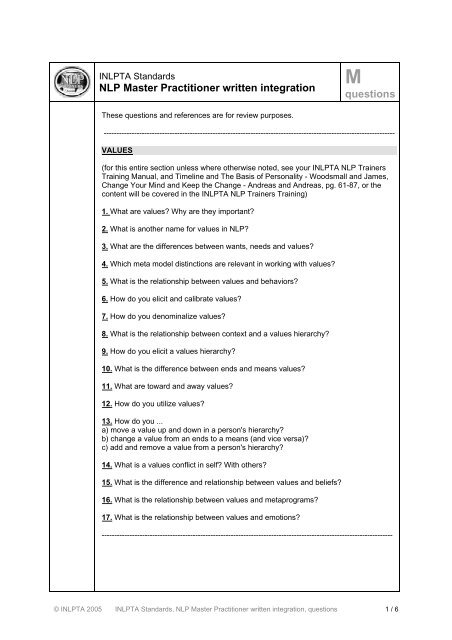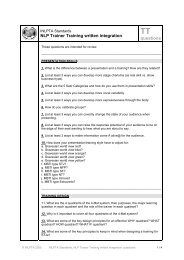NLP Master Practitioner written integration questions - INLPTA
NLP Master Practitioner written integration questions - INLPTA
NLP Master Practitioner written integration questions - INLPTA
Create successful ePaper yourself
Turn your PDF publications into a flip-book with our unique Google optimized e-Paper software.
I<strong>NLP</strong>TA Standards<br />
<strong>NLP</strong> <strong>Master</strong> <strong>Practitioner</strong> <strong>written</strong> <strong>integration</strong><br />
M<br />
<strong>questions</strong><br />
These <strong>questions</strong> and references are for review purposes.<br />
-------------------------------------------------------------------------------------------------------------------<br />
VALUES<br />
(for this entire section unless where otherwise noted, see your I<strong>NLP</strong>TA <strong>NLP</strong> Trainers<br />
Training Manual, and Timeline and The Basis of Personality - Woodsmall and James,<br />
Change Your Mind and Keep the Change - Andreas and Andreas, pg. 61-87, or the<br />
content will be covered in the I<strong>NLP</strong>TA <strong>NLP</strong> Trainers Training)<br />
1. What are values? Why are they important?<br />
2. What is another name for values in <strong>NLP</strong>?<br />
3. What are the differences between wants, needs and values?<br />
4. Which meta model distinctions are relevant in working with values?<br />
5. What is the relationship between values and behaviors?<br />
6. How do you elicit and calibrate values?<br />
7. How do you denominalize values?<br />
8. What is the relationship between context and a values hierarchy?<br />
9. How do you elicit a values hierarchy?<br />
10. What is the difference between ends and means values?<br />
11. What are toward and away values?<br />
12. How do you utilize values?<br />
13. How do you ...<br />
a) move a value up and down in a person's hierarchy?<br />
b) change a value from an ends to a means (and vice versa)?<br />
c) add and remove a value from a person's hierarchy?<br />
14. What is a values conflict in self? With others?<br />
15. What is the difference and relationship between values and beliefs?<br />
16. What is the relationship between values and metaprograms?<br />
17. What is the relationship between values and emotions?<br />
-------------------------------------------------------------------------------------------------------------------<br />
© I<strong>NLP</strong>TA 2005 I<strong>NLP</strong>TA Standards, <strong>NLP</strong> <strong>Master</strong> <strong>Practitioner</strong> <strong>written</strong> <strong>integration</strong>, <strong>questions</strong> 1 / 6
METAPROGRAMS<br />
(for this entire section unless where otherwise noted, see your I<strong>NLP</strong>TA <strong>NLP</strong> Trainers<br />
Training Manual, Timeline and The Basis of Personality - Woodsmall and James, Wyatt<br />
Woodsmall=s manual on Metaprograms, or the content will be covered in the I<strong>NLP</strong>TA<br />
<strong>NLP</strong> Trainers Training)<br />
18. What is a metaprogram? Why are they important?<br />
19. What is the difference and relationship between metaprograms and strategies?<br />
20. What are the following metaprograms?<br />
a) define each<br />
b) explain how to elicit and detect them<br />
c) give some applications in your area of interest (e.g. business, therapy, health,<br />
education, performance enhancement, etc.)<br />
a. Toward-Away<br />
b. Internal-External (with check)<br />
c. Global-Specific (with direction)<br />
d. Sameness-Difference (with exception)<br />
e. Proactive-(P)Reactive-Inactive<br />
f. Possibility-Necessity<br />
g. In Time-Through Time<br />
h. Primary Interest - People, Place, Activity, Things, Information<br />
i. Activity Things, Activity People, Activity Systems<br />
j. Self-Others (and Loop)<br />
k. Convincer (rep system, time frame)<br />
l. Options-Procedures<br />
m. Index Computations - Internal Processing, Internal State, External Behavior<br />
n. Past-Present-Future-Atemporal<br />
o. Challenge-Ease<br />
p. Power-Affiliation-Achievement<br />
q. Independent-Proximity-Team/Cooperation<br />
r. Toward/Away from Harmony - Toward/Away from Disharmony<br />
s. Task-Maintenance<br />
t. Decision Sort - Looks Right, Sounds Right, Feels Right, Makes Sense<br />
u. Rule Structure - combinations of My Rules, Your Rules, No Rules, Our Rules, Their<br />
Rules, THE Rules<br />
v. Contextual-Detailed<br />
21. What are some ways to change from one metaprogram sort to another?<br />
22. List at least 5 ways you can develop more requisite variety with metaprogram<br />
sorting.<br />
23. How do you do the Disney Pattern?<br />
- Tools for Dreamers - Dilts, Dilts, Epstein<br />
Strategies of Genius - Dilts, pg.161-216<br />
-------------------------------------------------------------------------------------------------------------------<br />
LOGICAL LEVELS AND LOGICAL TYPES<br />
24. What are logical levels? Why are they important?<br />
25. What are logical types? Why are they important?<br />
Structure of Magic Vol. 2. - Bandler and Grinder pg. 33-36<br />
26. How do you track for logical levels?<br />
© I<strong>NLP</strong>TA 2005 I<strong>NLP</strong>TA Standards, <strong>NLP</strong> <strong>Master</strong> <strong>Practitioner</strong> <strong>written</strong> <strong>integration</strong>, <strong>questions</strong> 2 / 6
27. How do you track for logical types?<br />
28. How do you create a therapeutic double bind?<br />
- Trance-Formations - Bandler and Grinder, pg. 125-126<br />
29. How do you break a limiting double bind?<br />
-------------------------------------------------------------------------------------------------------------------<br />
CRITERIA UTILIZATION PATTERNS<br />
(for this entire section unless where otherwise noted, see your I<strong>NLP</strong>TA <strong>NLP</strong> Trainers<br />
Training Manual)<br />
30. What are Criteria Utilization Patterns?<br />
31. What is another name for Criteria Utilization Patterns?<br />
32. What are the two forms of surface structures on which Criteria Utilization Patterns<br />
can be best applied?<br />
33. When are Criteria Utilization Patterns useful? Name at least 3 contexts.<br />
34. List the Criteria Utilization Patterns that you know.<br />
-------------------------------------------------------------------------------------------------------------------<br />
MODELING<br />
(for this entire section unless where otherwise noted, see your I<strong>NLP</strong>TA <strong>NLP</strong> Trainers<br />
Training Manual)<br />
35. What is modeling?<br />
36. What is the difference between Modeling I and Modeling II?<br />
37. What is the difference between inside and outside modeling?<br />
38. What are the keys to inside modeling?<br />
39. What are the key components of outside modeling?<br />
40. What is the test for modeling success?<br />
41. What are the by-products of the modeling process?<br />
42. What are the steps of the modeling process?<br />
43. What are the components of genius?<br />
44. What is the relationship between pre-selection and training?<br />
45. What are heuristics?<br />
46. What is task decomposition and why is it important?<br />
47. What is contrastive analysis?<br />
-------------------------------------------------------------------------------------------------------------------<br />
© I<strong>NLP</strong>TA 2005 I<strong>NLP</strong>TA Standards, <strong>NLP</strong> <strong>Master</strong> <strong>Practitioner</strong> <strong>written</strong> <strong>integration</strong>, <strong>questions</strong> 3 / 6
BELIEFS<br />
(for this entire section unless where otherwise noted, see Beliefs - Dilts, Hallbolm and<br />
Smith, and Changing Belief Systems with <strong>NLP</strong> - Dilts)<br />
48. What are beliefs? Why are they important?<br />
49. How are beliefs different from values?<br />
50. What is the difference between believing and knowing?<br />
51. What is a belief system?<br />
52. What are core beliefs?<br />
53. How do you elicit and detect core beliefs?<br />
54. What is a belief molecule? How do you work with it?<br />
55. Name at least 3 different techniques you know for changing beliefs. Give a brief<br />
outline of each.<br />
56. What is the difference and relationship between a belief strategy and: a convincer<br />
strategy, a reality strategy, and a truth strategy<br />
57. When and how would you do an identity level change?<br />
-------------------------------------------------------------------------------------------------------------------<br />
TIME CODES AND TIMELINE<br />
(for this entire section unless where otherwise noted, see Timeline and The Basis of<br />
Personality - Woodsmall and James, Wyatt Woodsmall's manual entitled Time Codes,<br />
Heart of the Mind - Andreas and Andreas pgs. 191-212, Change your Mind and Keep<br />
the Change, - Andreas and Andreas, pgs.!-36)<br />
58. What are temporal submodalities?<br />
59. What is a time code?<br />
60. What is a timeline?<br />
61. What is the significance of the typology of a timeline?<br />
62. How do you shift a timeline?<br />
63. What is the basic pattern for a timeline intervention?<br />
64. How do you do a decision destroyer? When would you use it?<br />
- <strong>NLP</strong>, The New Technology of Achievement - Andreas and Faulkner, pgs. 275-277<br />
65. How do you do the now patterns?<br />
66. What is the relationship between the 4 time orientations (past, present, future,<br />
atemporal) and emotions?<br />
-------------------------------------------------------------------------------------------------------------------<br />
© I<strong>NLP</strong>TA 2005 I<strong>NLP</strong>TA Standards, <strong>NLP</strong> <strong>Master</strong> <strong>Practitioner</strong> <strong>written</strong> <strong>integration</strong>, <strong>questions</strong> 4 / 6
EMOTIONS<br />
67. What is the difference and relationship between sensations, feelings and emotions?<br />
- See you I<strong>NLP</strong>TA <strong>NLP</strong> Trainers Training manual<br />
68. How would you use timeline as an intervention to change emotions?<br />
- Timeline and The Basis of Personality - Woodsmall and James, Wyatt Woodsmall's<br />
manual entitled Time Codes, Heart of the Mind - Andreas and Andreas pgs. 191-212,<br />
Change your<br />
- Mind and Keep the Change, - Andreas and Andreas, pgs.!-36, The Emotional<br />
Hostage - Cameron-Bandler, pg. 57-59<br />
-------------------------------------------------------------------------------------------------------------------<br />
SEMANTIC PRIMES<br />
(this entire section will be covered in the I<strong>NLP</strong>TA <strong>NLP</strong> Trainers Training)<br />
69. What is a semantically dense or semantically packed word?<br />
70. What is a semantic prime?<br />
71. What is a semantic response?<br />
72. What are prime concerns?<br />
-------------------------------------------------------------------------------------------------------------------<br />
OTHER<br />
73. How do you create and utilize a sliding anchor?<br />
- will be covered in the I<strong>NLP</strong>TA <strong>NLP</strong> Trainers Training<br />
74. How do you do submodality chaining?<br />
- Insiders Guide to Submodalities - Bandler and MacDonald, pg. 76-81<br />
75. What is the Meta Model 3 format?<br />
- will be covered in the I<strong>NLP</strong>TA <strong>NLP</strong> Trainers Training<br />
76. What is reimprinting? How do you do it?<br />
- Changing Belief Systems with <strong>NLP</strong> - Dilts<br />
- Beliefs - Dilts, Hallbolm, Smith, Chapter 4<br />
77. How do you do the Meta Mirror?<br />
- Changing Belief Systems with <strong>NLP</strong> - Dilts pg. 190-199<br />
78. How do you unwire a synesthesia through circuitry clearing?<br />
- Changing Belief Systems with <strong>NLP</strong> - Dilts<br />
79. What other ways do you know of to unwire a synesthesia? Name at least 3 and<br />
give a brief explanation of each.<br />
80. What is your evidence procedure for knowing your work is ecological?<br />
81. How do you approach making a systems intervention? (i.e. families, teams, etc.)<br />
- Structure of Magic Vol. 2 - Bandler and Grinder pg. 123-161<br />
82. How do you approach resolving a team crisis as a mediator?<br />
- Structure of Magic Vol. 2 - Bandler and Grinder pg. 123-161<br />
© I<strong>NLP</strong>TA 2005 I<strong>NLP</strong>TA Standards, <strong>NLP</strong> <strong>Master</strong> <strong>Practitioner</strong> <strong>written</strong> <strong>integration</strong>, <strong>questions</strong> 5 / 6
83. How has your life significantly changed by your <strong>integration</strong> of your <strong>Master</strong><br />
<strong>Practitioner</strong> skills, and how will you continue to make evolutionary changes for yourself<br />
into the future?<br />
I<strong>NLP</strong>TA USA / America<br />
Wyatt Woodsmall<br />
1201 Delta Glen Court<br />
Vienna, VA 22182-1320<br />
phone (703) 757-7945<br />
fax (703) 757-7946<br />
www.inlpta.com<br />
wyattwoodsmall@compuserve.com<br />
I<strong>NLP</strong>TA Europe<br />
Bert Feustel<br />
Herzogstr. 83<br />
80796 München<br />
phone ++49 / [0] 89 / 30779962<br />
fax: ++49 / [0] 941 / 5992 30813<br />
www.inlpta.org<br />
bert.feustel@inlpta.org<br />
© I<strong>NLP</strong>TA 2005 I<strong>NLP</strong>TA Standards, <strong>NLP</strong> <strong>Master</strong> <strong>Practitioner</strong> <strong>written</strong> <strong>integration</strong>, <strong>questions</strong> 6 / 6



